Welcome to our no fuss guide on orange birds found in the US. We’ve listed the ten birds you’re most likely to see.
You can use the images directly below if you’re trying to figure out which bird you’re looking at now, the table if you want to know a bit about the bird, or each bird is covered in detail below that.
Happy birding!
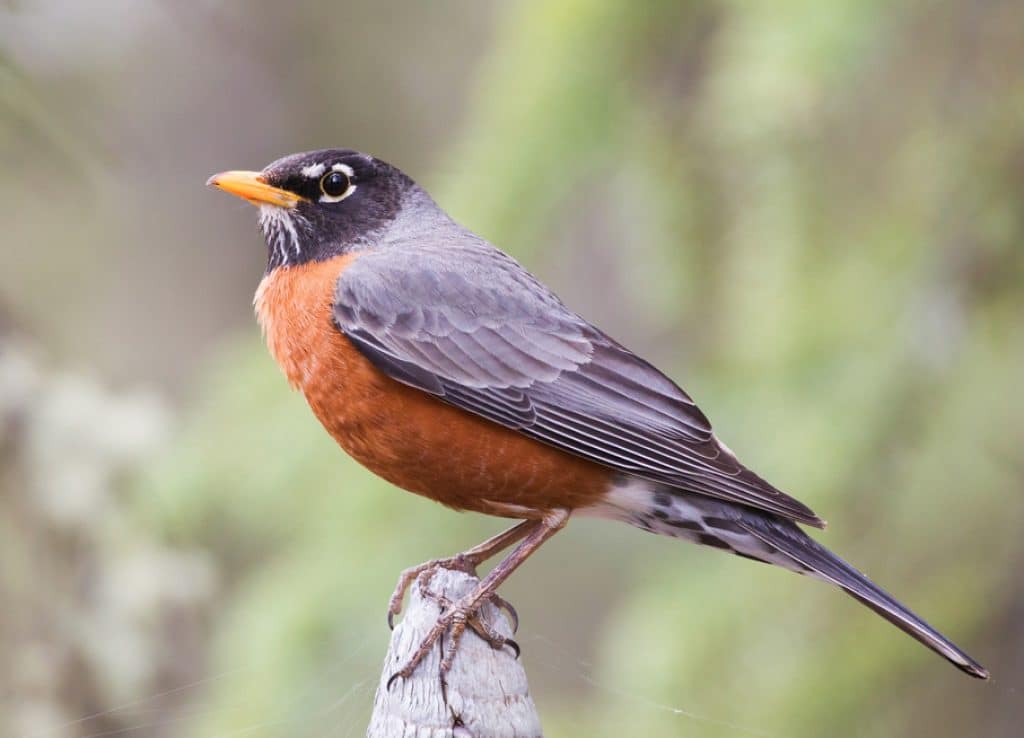
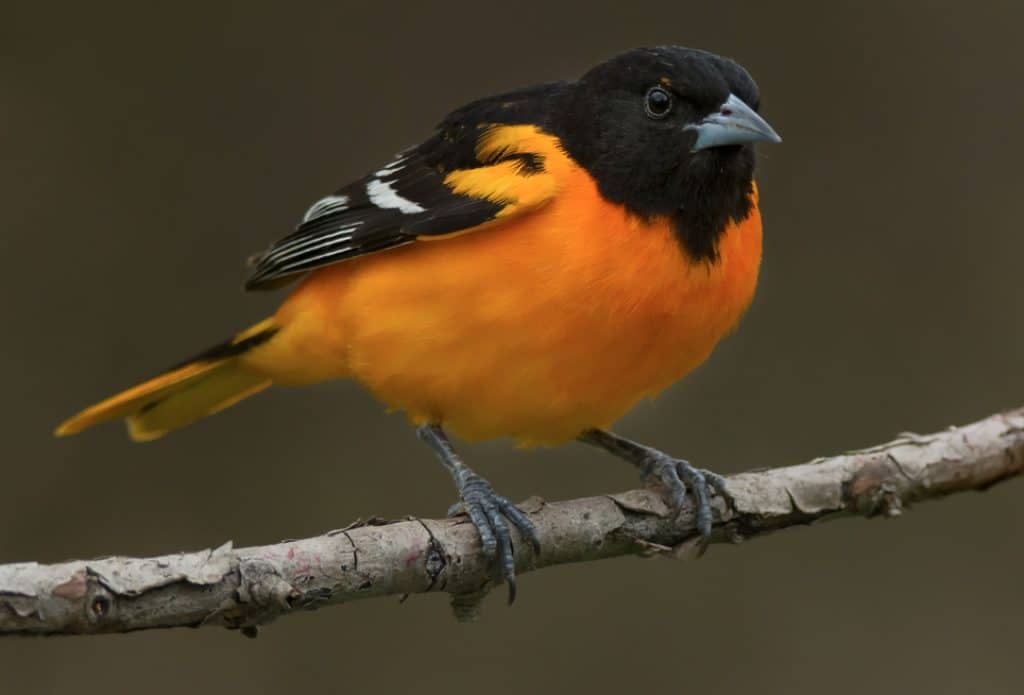
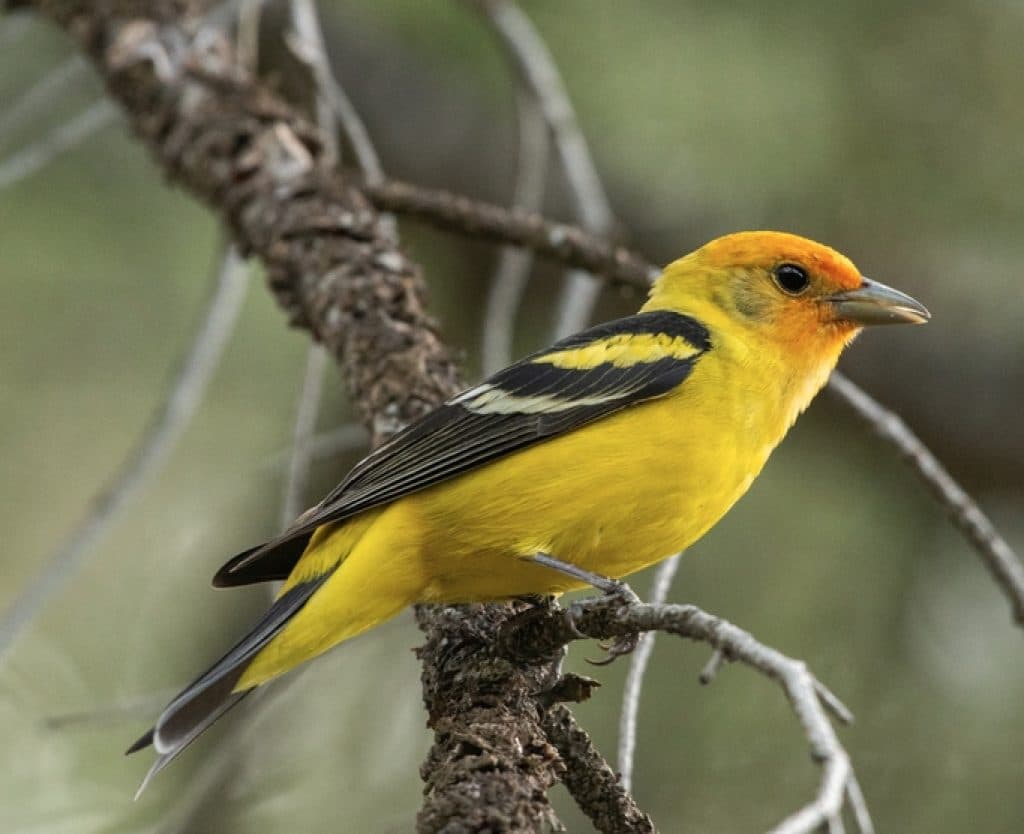
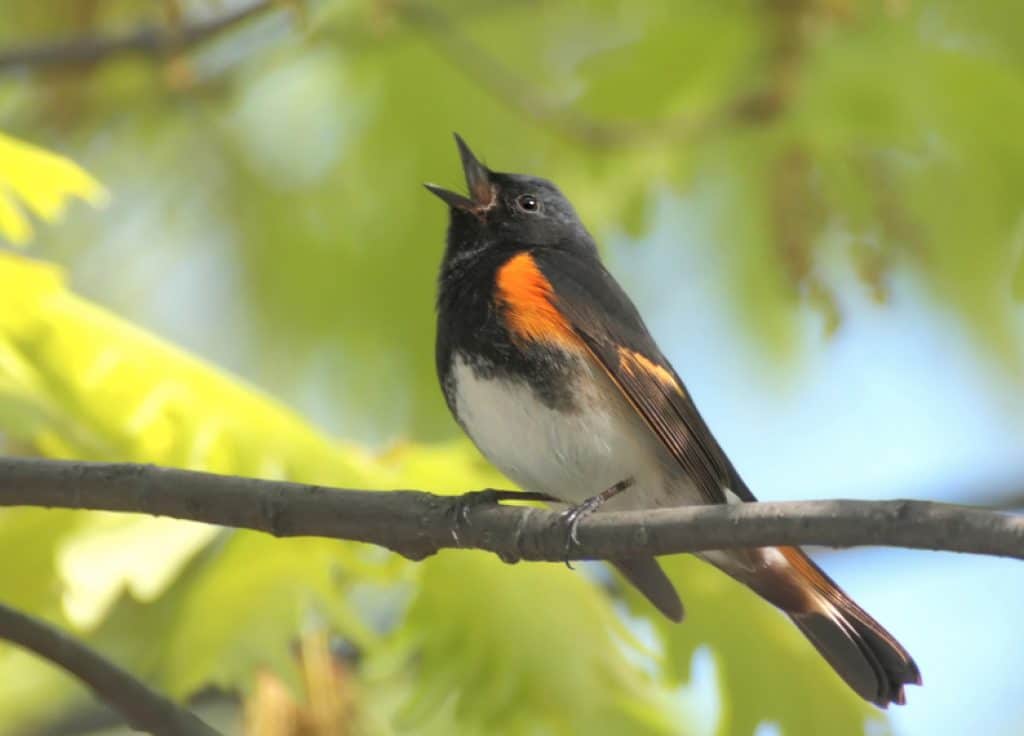
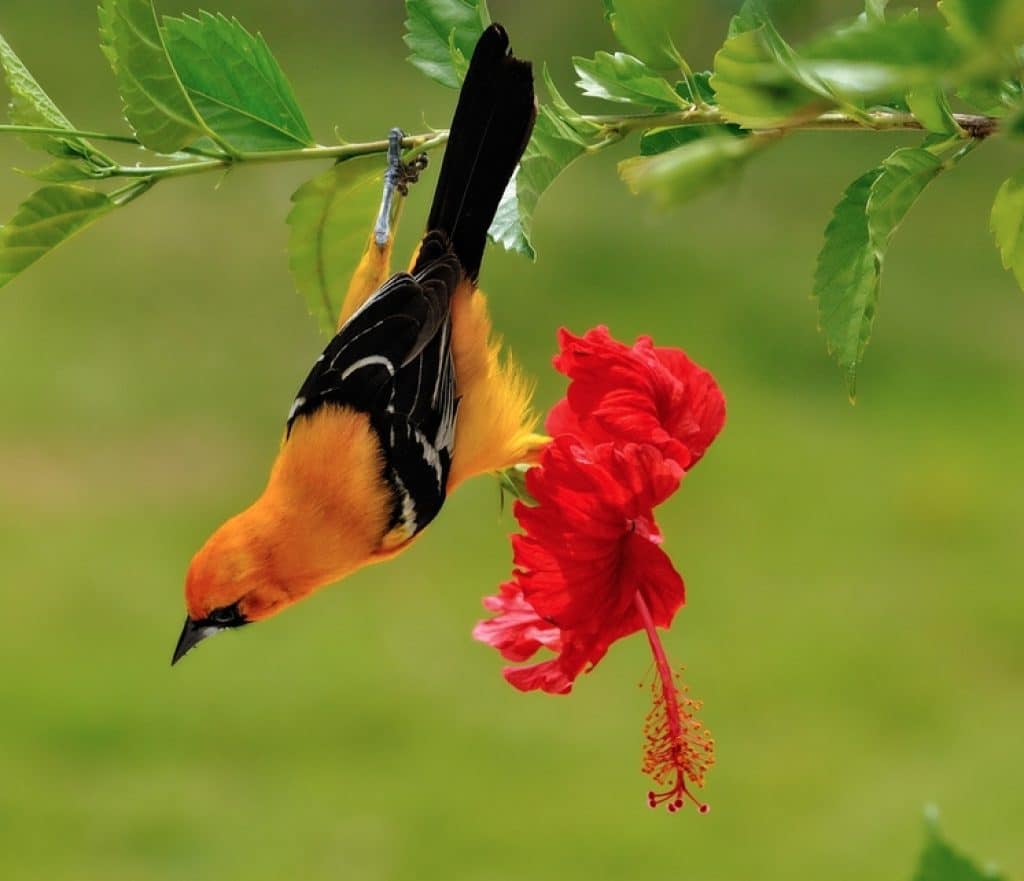
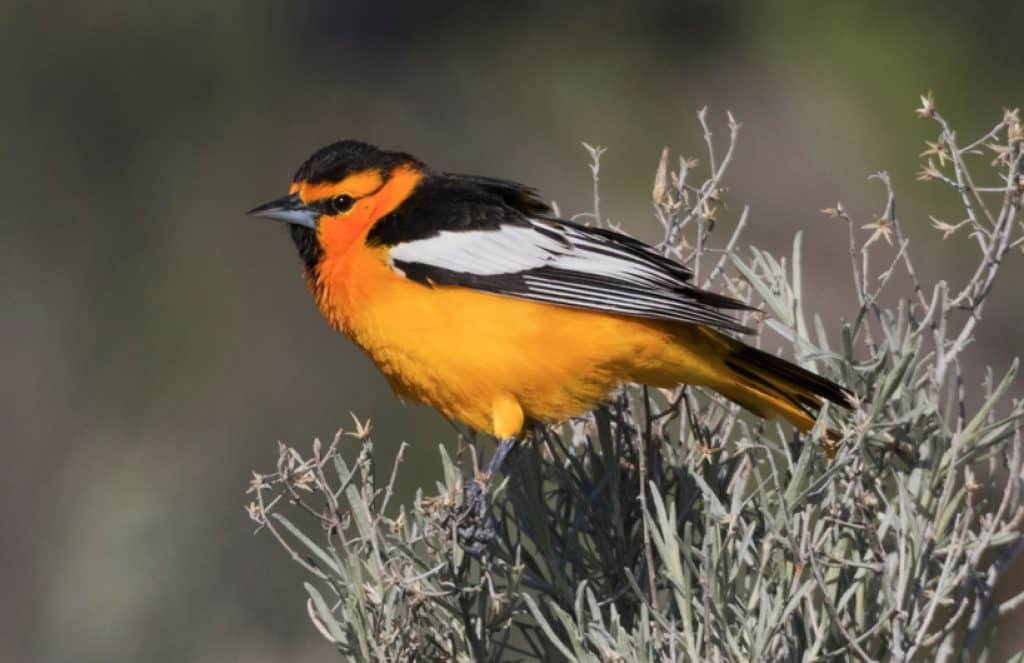
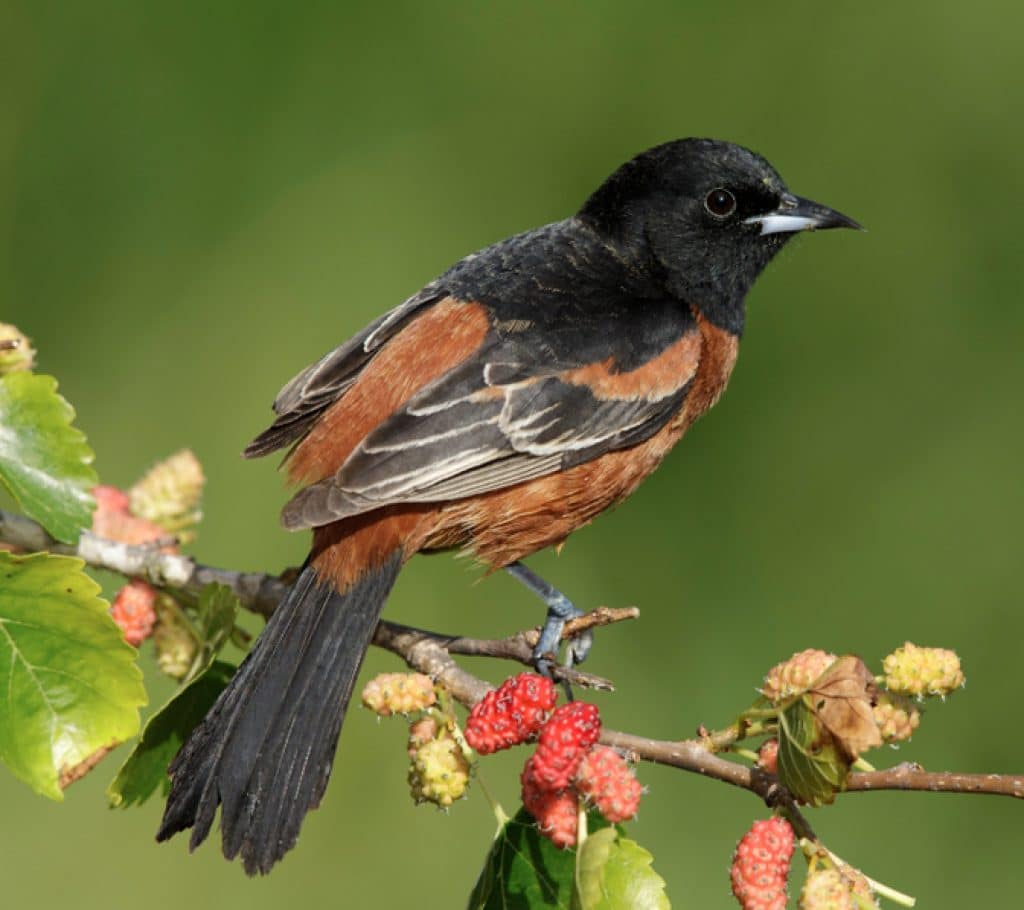
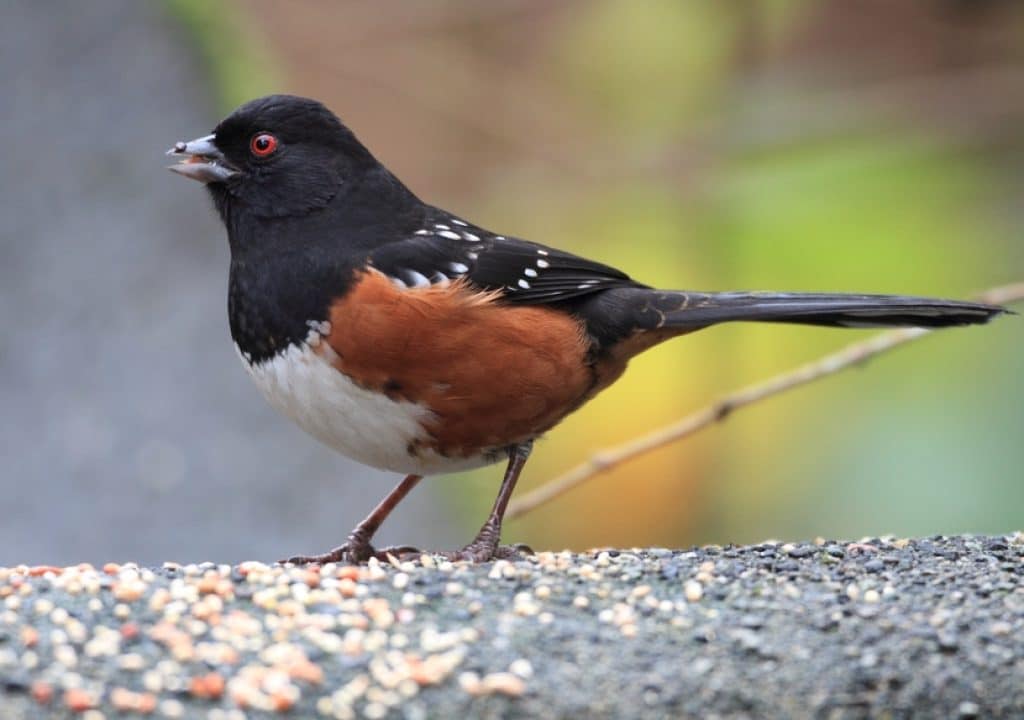
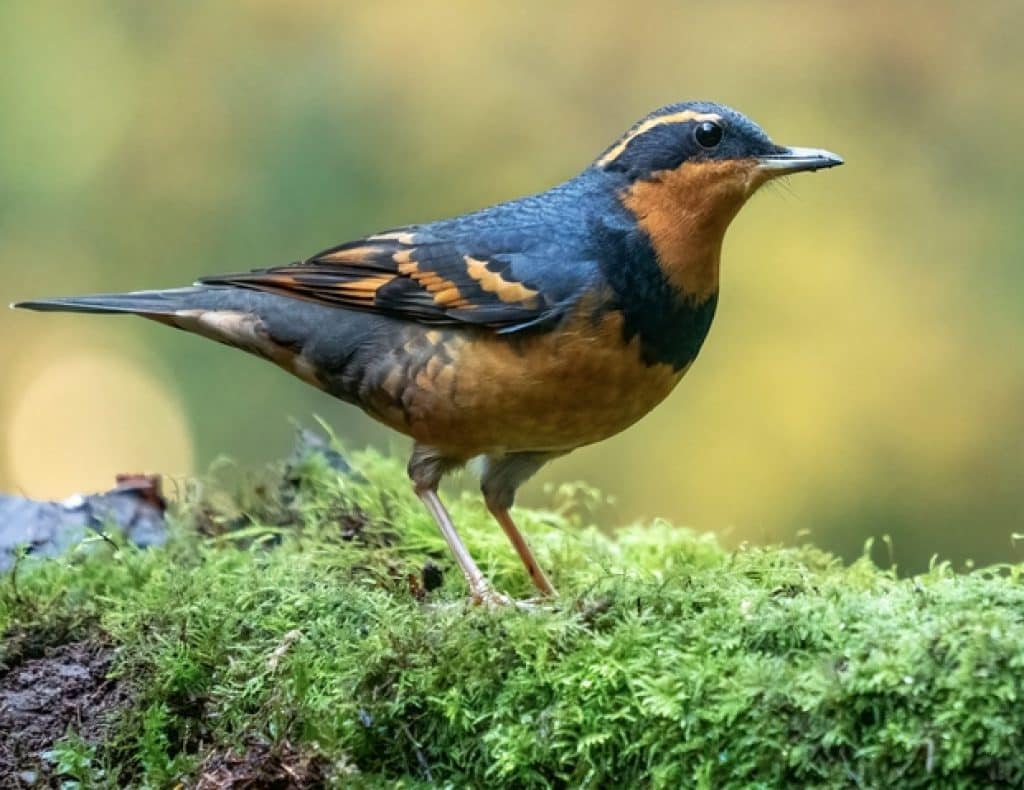
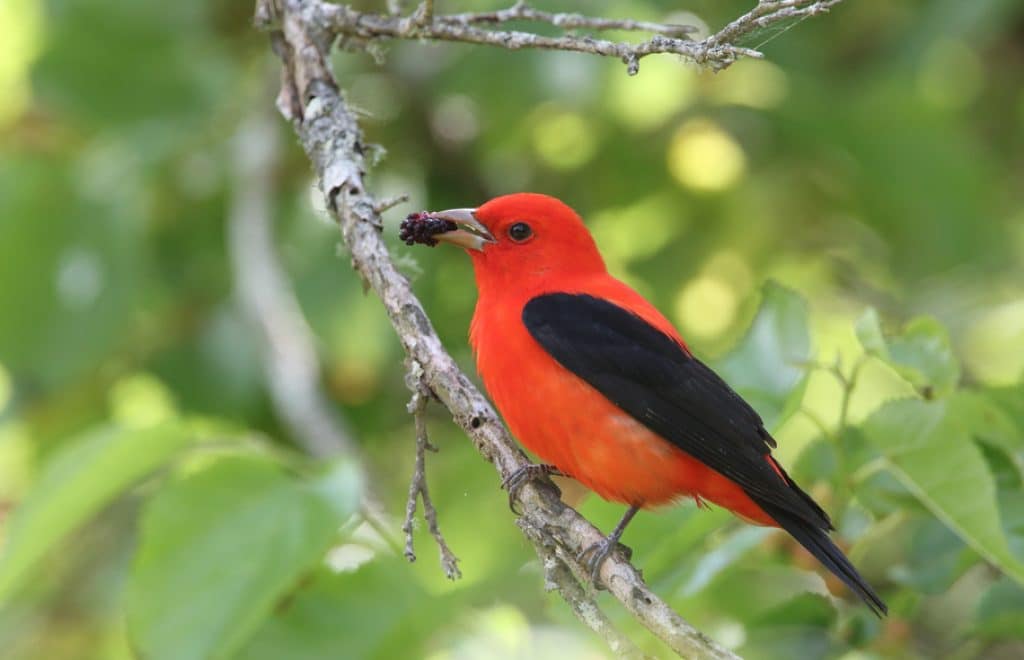
| Bird Species & Scientific Name | Image | Migrates | Physical Description | Preferred Habitat |
|---|---|---|---|---|
| American Robin (Turdus migratorius) |  | Yes | Gray-brown above with a bright orange underbelly and dark head. | Lawns, gardens, wooded areas |
| Baltimore Oriole (Icterus galbula) |  | Yes | Males are bright orange and black; females are more brownish-orange. | Open woodlands, riversides, parks |
| Western Tanager (Piranga ludoviciana) |  | Yes | Males have a bright orange body, black back, wings, and tail; females are yellowish. | Coniferous forests |
| American Redstart (Setophaga ruticilla) |  | Yes | Males are black with bright orange patches; females and young are gray with yellow patches. | Deciduous forests |
| Altamira Oriole (Icterus gularis) |  | Partially | Bright orange body with a black throat, upper back, and wings. | Brushy areas, open woodlands |
| Bullock’s Oriole (Icterus bullockii) |  | Yes | Males have a bright orange chest and belly with a black head and back; females are more yellowish-orange. | Open woods, groves |
| Orchard Oriole (Icterus spurius) |  | Yes | Adult males have chestnut and black coloration, with younger males showing more orange. | Open woodlands, orchards, parks |
| Spotted Towhee (Pipilo maculatus) | \ | Partially | Black above with white spots and a long tail; sides are orange. | Brushy and wooded areas |
| Varied Thrush (Ixoreus naevius) |  | Partially | Males have a slate gray back and head, with an orange belly and throat; females are similar but duller. | Dense moist forests |
| Scarlet Tanager (Piranga olivacea) |  | Yes | Males are bright red with black wings and tail; females are yellowish, but juveniles and non-breeding males can show orange. | Deciduous forests |
1. American Robin (Turdus migratorius)

Our first bird, the American Robin (Turdus migratorius), is one of the most recognizable and widespread orange songbirds in North America. Known for its bright orange belly and melodious song, the American Robin heralds the arrival of spring in many areas. Let’s take a closer look at this familiar bird:
Identification
- Size and Shape: American Robins are medium-sized songbirds with a large, round body, long legs, and a straight, fairly long tail. Their silhouette is instantly recognizable with a robust and upright posture.
- Color Pattern: They have a distinctive orange or reddish breast, contrasting with their gray back, wings, and head. Males and females look similar, though males tend to have slightly brighter coloring.
Behavior
- Feeding Habits: Robins are known for their diet of earthworms, often seen pulling worms from the soil. They also eat a wide variety of fruits and berries, adjusting their diet as the seasons change.
- Vocalizations: The song of the American Robin is a series of clear, melodious phrases, each consisting of a few notes, repeated several times. Their calls include a sharp, alarm-like “chirp.”
- Migration and Winter Behavior: While some American Robins migrate to warmer climates for the winter, others remain in their breeding range year-round, forming large flocks and feeding on fruit and berries.
Habitat
- Versatile Dwellers: American Robins are comfortable in a variety of habitats, including forests, gardens, parks, and urban areas. They are adaptable birds, often among the first to return to northern breeding grounds in spring.
- Nesting: They build their nests in trees or on buildings, using grass, twigs, and mud. The female lays and incubates a clutch of blue eggs, known colloquially as “robin’s eggs.”
Conservation Status
- Abundant and Widespread: The American Robin is common across its range, with stable and healthy population numbers. Their adaptability to different environments has helped them thrive in varied landscapes.
Tips for Watching
- Attracting Robins: Providing a bird bath or a source of water can attract American Robins to your yard. Planting berry-producing bushes and trees can also encourage them to visit and stay.
- Observation Tips: Look for American Robins foraging on the ground in lawns, parks, and open fields. Early morning and late afternoon are great times to hear their beautiful song.
- Enjoy Their Presence: American Robins are a sign of the changing seasons, and their familiar song and appearance make them a beloved sight in many areas.
The American Robin’s bright plumage, cheerful song, and presence in backyards and wildlands alike make it a quintessential part of the North American landscape, embodying the spirit of spring and renewal.
2. Baltimore Oriole (Icterus galbula)

Our second bird, the Baltimore Oriole (Icterus galbula), is a stunning songbird known for its vibrant orange and black plumage. This bird is not only a treat for the eyes but also for the ears, with its melodious whistling tunes. Baltimore Orioles are a beloved sight in eastern and central North America during the warmer months, where they breed in open woodlands and gardens. Let’s delve into the details of this colorful songbird:
Identification
- Size and Shape: Baltimore Orioles are medium-sized songbirds with a slender body, a pointed bill that’s slightly curved downward, and a long tail. Their build is sleek and agile, suited for their acrobatic foraging habits.
- Color Pattern: Males are easily identifiable by their brilliant orange underparts and shoulders, contrasted with their black head, back, wings, and tail. Females and juveniles are more subdued, with yellow-orange underparts and a grayish to brownish back.
Behavior
- Feeding Habits: They have a sweet tooth, often seeking out fruit and nectar. They’re also adept insect hunters, snatching beetles, caterpillars, and spiders from trees and shrubs. Their preference for nectar and fruit can make them frequent visitors to backyard feeders, especially those offering orange slices, jelly, or nectar.
- Vocalizations: The Baltimore Oriole’s song is a series of rich, whistled notes, varying in pitch and rhythm. Their clear, flute-like songs and calls are a distinctive and eagerly awaited sound of spring and early summer.
- Nesting: Unique among North American songbirds, Baltimore Orioles weave a hanging nest from fibrous materials like plant fibers, fishing line, and hair. These nests are often found dangling from the tips of branches, swaying in the breeze.
Habitat
- Breeding and Migratory Range: Baltimore Orioles breed in the eastern and central United States and migrate to Central America for the winter. They prefer open woodlands, forest edges, and are commonly found in suburban parks and backyards, where they can find suitable food and nesting sites.
- Adaptability: While they prefer areas with large, mature trees, Baltimore Orioles have adapted well to human-modified landscapes, often nesting in orchards, along riverside woods, and in backyards that provide the right conditions.
Conservation Status
- Stable but Monitoring Required: The Baltimore Oriole population is considered stable, though it faces threats from habitat loss both in its breeding and wintering ranges. Conservation efforts focus on protecting forests in both North and Central America.
Tips for Watching
- Attracting Baltimore Orioles: To attract Baltimore Orioles to your yard, hang feeders with orange slices, grape jelly, or nectar in the spring. Providing fresh water and nesting materials can also encourage them to stay.
- Observation Tips: Look for these orioles in the canopy of trees, where they often feed and sing. Early morning is a great time for birdwatching, as the males are most vocal during this time.
- Photography: Their striking colors make Baltimore Orioles excellent subjects for photography, especially when captured against the lush green backdrop of their preferred habitats.
The Baltimore Oriole’s vivid colors and sweet song make it a highly anticipated visitor to eastern and central North America each spring, symbolizing the vibrant life of summer. Their presence is a reminder of the beauty and complexity of our natural ecosystems.
3. Western Tanager (Piranga ludoviciana)

Our third bird, the Western Tanager (Piranga ludoviciana), is a dazzling songbird that graces the western regions of North America with its presence.
With a striking combination of colors, this bird is a visual delight, featuring a blend of bright yellow, bold red, and deep black.
The Western Tanager’s range during breeding season extends from the western United States into Canada, making it a cherished sight for birdwatchers in those areas. Let’s explore the captivating characteristics of the Western Tanager:
Identification
- Size and Shape: Western Tanagers are medium-sized songbirds with a stout body, a thick neck, and a somewhat short, rounded tail. They possess a fairly large, conical bill that’s adept at handling a variety of foods.
- Color Pattern: Males are particularly striking, with a bright red face, yellow body, and black back, wings, and tail. Females and juveniles are more subdued, primarily yellow with grayish back and wings, lacking the male’s vivid red head.
Behavior
- Feeding Habits: These birds are primarily insectivores, feeding on wasps, beetles, and other insects. However, they also enjoy fruits and berries, particularly during migration and in their winter habitats. Their foraging habits take them across a variety of tree species, where they skillfully pluck insects from foliage and bark.
- Vocalizations: The Western Tanager’s song is a series of clear, melodious phrases, reminiscent of other American songbirds but with its own unique twist. Their call, a sharp “pit-er-ick,” is distinctive and often used to communicate among individuals or signal alarm.
- Migration: Western Tanagers migrate long distances between their breeding grounds in the western U.S. and Canada and their wintering areas in Central America. This journey highlights their adaptability and resilience.
Habitat
- Breeding and Wintering Grounds: During the breeding season, they prefer open coniferous forests and mixed woodlands, where they find ample food and nesting sites. In winter, they move to tropical forests, where they can continue to feed on insects and fruits.
- Nesting: Western Tanagers build their nests in trees, often choosing a horizontal branch well above the ground. The nest is a shallow cup made of grasses and small twigs, where the female lays and incubates her eggs.
Conservation Status
- Stable Population: The Western Tanager population is currently stable, with no immediate conservation concerns. However, like many migratory birds, they are vulnerable to habitat loss and changes in their environment due to climate change and human activity.
Tips for Watching
- Attracting Western Tanagers: While they are less likely to visit feeders than some other birds, planting native fruit-bearing plants and maintaining insect-friendly gardens can attract them to your yard.
- Observation Tips: Look for Western Tanagers high in the trees, where their colorful plumage can stand out against the green foliage. Early morning is often the best time to see and hear them as they are most active.
- Respect Their Space: When observing or photographing these birds, especially during the breeding season, it’s important to keep a respectful distance to avoid disturbing them or their nests.
The Western Tanager’s stunning appearance and melodious song make it a highlight of the western North American avian world, bringing a splash of color and music to the forests and woodlands it inhabits.
4. American Redstart (Setophaga ruticilla)

Our fourth bird, the American Redstart (Setophaga ruticilla), is a lively and colorful songbird, known for its distinctive tail-flashing behavior and striking plumage.
This member of the warbler family is admired for its energetic foraging style and vibrant appearance, making it a favorite among birdwatchers.
The American Redstart’s range covers much of North America during the breeding season, where it can be found in deciduous forests and woodland edges. Let’s dive into the fascinating world of the American Redstart:
Identification
- Size and Shape: American Redstarts are small, slender songbirds with a relatively wide, flat bill, indicative of their insectivorous diet. They have a long, fan-shaped tail, which they often spread open, revealing bright color patches.
- Color Pattern: Males are unmistakable with their black plumage contrasted by vivid orange patches on their sides, wings, and tail. Females and immature birds are more subdued, with grayish or olive tones and yellow patches instead of orange.
Behavior
- Feeding Habits: They are primarily insectivores, catching insects in mid-air with remarkable agility. Their foraging technique often involves flashing their tails to startle prey into moving, making them easier to catch.
- Vocalizations: The song of the American Redstart is a series of high-pitched, musical notes that can vary significantly between individuals. Their call is a sharp, crisp “chep,” used for communication between birds, especially in dense foliage.
- Territorial and Migratory: During the breeding season, males vigorously defend their territories. American Redstarts are long-distance migrants, spending the winter in Central America and the northern part of South America, where they continue their acrobatic foraging in tropical forests.
Habitat
- Breeding and Wintering Grounds: In North America, they prefer young deciduous forests and areas with a dense understory for breeding. Their winter habitats include tropical forests and second-growth areas, where they can find ample food sources.
- Nesting: American Redstarts build their nests in the forks of tree branches, weaving together a cup-shaped structure lined with fine materials. The female is primarily responsible for nest building and incubation.
Conservation Status
- Generally Stable: The American Redstart population is considered stable, though they, like many migratory bird species, are susceptible to habitat loss and changes in both their breeding and wintering grounds. Conservation efforts are focused on protecting vital habitats along their migratory routes.
Tips for Watching
- Attracting American Redstarts: Creating a bird-friendly backyard with native plants and a diverse understory can attract American Redstarts during migration. They are particularly drawn to areas that mimic their natural breeding and foraging habitats.
- Observation Tips: Look for American Redstarts flitting among trees and shrubs, often near the edge of woods or in open forests. Their distinctive foraging behavior and tail-flashing are key indicators of their presence.
- Enjoy Their Beauty: The vivid contrast in the plumage of male American Redstarts and their dynamic movements make them an enjoyable species to watch. Using binoculars, observe them from a distance to minimize disturbance.
The American Redstart adds a dash of color and energy to the forests and woodlands of North America, captivating birdwatchers with its vibrant appearance and lively behavior.
5. Altamira Oriole (Icterus gularis)

Our fifth bird, the Altamira Oriole (Icterus gularis), is a stunningly vibrant songbird, known for its striking orange and black plumage.
This large oriole is predominantly found in the southernmost tip of Texas in the United States, extending through eastern Mexico, Central America, and into northern parts of South America.
Its bold colors and melodious song make the Altamira Oriole a highlight of the regions it inhabits. Let’s delve into the fascinating attributes of the Altamira Oriole:
Identification
- Size and Shape: The Altamira Oriole is one of the larger species within the oriole family, with a long body, a sturdy bill, and a tail that is often held upright. Their build is robust, suited to their strong and agile foraging habits.
- Color Pattern: They boast a vivid orange or yellow-orange body, with contrasting black on their throat, back, wings, and tail. The face is also orange with a distinctive black eye line and bill, creating a striking visual contrast.
Behavior
- Feeding Habits: Altamira Orioles are omnivorous, feeding on a variety of insects, fruits, and nectar. They often forage in the canopy, skillfully extracting their food from flowers and foliage with their strong bills.
- Vocalizations: Their song is a series of rich, melodious whistles, which can vary in pitch and duration. The song serves multiple purposes, including territory defense, mate attraction, and communication between individuals.
- Nesting: Unique among North American orioles, the Altamira Oriole constructs an impressively long, hanging nest, often more than two feet in length, from fibers and grasses. These nests are typically attached to the ends of tree branches, swaying in the breeze.
Habitat
- Range and Habitat: In the U.S., their presence is mostly confined to the lower Rio Grande Valley in Texas, favoring areas with dense thickets, woodlands, and riparian corridors. Their range extends into more tropical habitats in Mexico and Central America.
- Adaptability: While they prefer habitats with ample tree cover and access to water, Altamira Orioles have shown adaptability by utilizing human-altered landscapes, such as orchards and parks, for feeding and nesting.
Conservation Status
- Stable in Limited U.S. Range: The Altamira Oriole’s population is considered stable within its relatively small U.S. range, but habitat loss and fragmentation are concerns, particularly in their broader range across Central America.
Tips for Watching
- Spotting Altamira Orioles: To observe Altamira Orioles, visit the lower Rio Grande Valley and explore areas with dense vegetation and trees. Their distinctive nests are often a giveaway to their presence in the area.
- Bird Feeding: While they may visit feeders for fruit or nectar, planting native flowering and fruit-bearing plants can also attract Altamira Orioles and provide natural foraging opportunities.
- Enjoy Their Splendor: The bright plumage and beautiful song of the Altamira Oriole make it a magnificent bird to observe. Early morning is often the best time to catch them active and singing.
The Altamira Oriole’s radiant appearance and enchanting song contribute to the biodiversity and allure of the southernmost natural environments in the United States and beyond, captivating birdwatchers and nature enthusiasts fortunate enough to encounter them.
6. Bullock’s Oriole (Icterus bullockii)

Our sixth bird, the Bullock’s Oriole (Icterus bullockii), is a striking songbird that brings a splash of color to the western parts of North America.
With its vibrant orange and black plumage, this oriole is a visual delight and an eagerly awaited sign of spring for many birdwatchers.
The Bullock’s Oriole is known for its melodious song and intricate hanging nests, showcasing the remarkable craftsmanship of these birds. Let’s delve into the attributes of the Bullock’s Oriole:
Identification
- Size and Shape: Bullock’s Orioles are medium-sized birds with a slender body, pointed bill, and a fairly long tail. Their build is graceful and agile, perfect for their acrobatic foraging habits.
- Color Pattern: Males display a brilliant orange body with a black throat, eye-line, back, and crown. They also have white wing bars on their black wings. Females are more subdued, with a yellowish-orange underpart and grayish back, featuring two white wing bars.
Behavior
- Feeding Habits: These orioles are adept at feeding on insects, nectar, and fruit. They exhibit fascinating feeding behaviors, such as hovering to extract nectar from flowers and skillfully plucking insects from tree bark and leaves.
- Vocalizations: The Bullock’s Oriole’s song is a series of clear, melodious whistles and chatters. Their vocal repertoire is varied, used for communication within the species, marking territory, and attracting mates.
- Nesting: They construct remarkable hanging nests, woven from plant fibers, grasses, and sometimes string or other man-made materials. These nests are usually attached to the tips of tree branches, swaying gently in the wind.
Habitat
- Range and Habitat Preferences: Bullock’s Orioles breed in open woodlands, riparian areas, and suburban settings with tall trees across the western United States and into Canada. They migrate to central and southern Mexico for the winter, where they can find a more temperate climate and ample food sources.
- Adaptability: While they have a preference for certain types of habitats, Bullock’s Orioles have shown adaptability by nesting in various environments, including orchards and parks, provided there are suitable nesting sites and food availability.
Conservation Status
- Generally Stable: The population of Bullock’s Oriole is considered stable, though it faces challenges such as habitat loss and the impact of pesticides on their food sources. Conservation efforts focus on preserving natural habitats and promoting practices that support a healthy ecosystem for these and other migratory birds.
Tips for Watching
- Attracting Bullock’s Orioles: To attract them to your backyard, offer nectar feeders, fresh fruit, and jelly. Planting native flowering plants can also provide natural nectar sources.
- Observation Tips: Look for Bullock’s Orioles in open wooded areas, particularly near water. Their distinctive nests and vibrant plumage make them easier to spot among the foliage.
- Enjoy Their Beauty: The contrast between the Bullock’s Oriole’s bright orange plumage and the greenery of their natural habitat provides stunning viewing opportunities. Early morning is often the best time to see them active and feeding.
The Bullock’s Oriole’s striking appearance and cheerful song make it a beloved bird in the western United States, symbolizing the vibrant life and diversity of the region’s ecosystems.
7. Orchard Oriole (Icterus spurius)

Our seventh bird, the Orchard Oriole (Icterus spurius), is the smallest North American oriole but brings a significant burst of color and melody to its environment.
This oriole is admired for its rich chestnut and black plumage in males and greenish-yellow in females. They have a sweet, melodious song and are often found in open woodlands, orchards, and along rivers and streams. Let’s explore the characteristics of the Orchard Oriole:
Identification
- Size and Shape: Orchard Orioles are relatively small for orioles, with a sleek and streamlined body, a sharp, straight bill, and a medium-length tail. Their compact size and agile flight make them excellent aerial foragers.
- Color Pattern: Adult males have a striking appearance with a black head, back, and chest, transitioning to a rich chestnut or brick red on the belly and underparts. Females and immature males are more subdued, with a yellowish-green coloration overall.
Behavior
- Feeding Habits: These birds are versatile feeders, consuming a diet that includes insects, fruits, and nectar. They are particularly fond of caterpillars, beetles, and spiders. Their feeding contributes to the control of insect populations, making them beneficial for gardens and orchards.
- Vocalizations: Orchard Orioles have a varied repertoire of songs and calls, including a series of whistles and chatters. Their song is less harsh than that of other oriole species, featuring clear, melodious notes.
- Nesting: They build hanging nests, woven from grass and plant fibers, often placed in the forks of tree branches. The nest’s construction is a testament to the bird’s skill, creating a secure place for eggs and nestlings.
Habitat
- Preferred Habitats: They favor open and semi-open landscapes, such as orchards, old fields, and areas along water bodies, where trees are present for nesting. They’re also commonly found in suburban areas with suitable vegetation.
- Range and Migration: Orchard Orioles breed across the eastern and central United States, migrating to Central America and the northern parts of South America for the winter. Their migration highlights the importance of conserving habitats across their range.
Conservation Status
- Stable Population: The Orchard Oriole population is considered stable, though it faces challenges from habitat loss, especially in its wintering grounds. Conservation initiatives aimed at protecting migratory bird habitats are crucial for their long-term survival.
Tips for Watching
- Attracting Orchard Orioles: To attract these orioles to your yard, offer fruit, nectar feeders, and small insects. Planting native flowering plants can also provide natural food sources and attract insects for them to feed on.
- Observation Tips: Look for Orchard Orioles in the canopy of open wooded areas or among the branches of fruit trees in orchards. Their distinctive song is often the best clue to their presence.
- Photography and Observation: With their striking colors and active behavior, Orchard Orioles make excellent subjects for photography. Use a long lens and patience to capture their beauty without disturbing their natural activities.
The Orchard Oriole’s presence enriches its habitat with bursts of color and sweet songs, contributing to the biodiversity of the regions it inhabits. Their adaptability to different environments makes them a joy to observe for birdwatchers and nature enthusiasts alike.
8. Spotted Towhee (Pipilo maculatus)

Our eighth bird, the Spotted Towhee (Pipilo maculatus), is a strikingly marked, large sparrow known for its bold patterning and vibrant presence in shrubby landscapes across the western United States.
With its deep black upperparts contrasting against white spots and a warm rufous side, this bird is not only a visual treat but also an auditory one, with its distinctive call and song.
Identification
- Size and Shape: Spotted Towhees are robust, large sparrows with thick necks, stout bills, and long, rounded tails. Their strong legs and feet are adapted for scratching and foraging in dense underbrush.
- Color Pattern: Males are unmistakable with their black upperparts interspersed with white spots and streaks, rufous flanks, and white belly. Females are similarly patterned but with a more subdued, brownish upper body instead of black.
Behavior
- Feeding Habits: These birds are ground feeders, using a characteristic two-footed, backward-scratching hop to uncover insects, seeds, and berries hidden in the leaf litter. Their diet varies with the seasons, adapting to available food sources.
- Vocalizations: The Spotted Towhee’s song is a loud, trilling “drink-your-teeeeea,” memorable and often heard in the early morning or late afternoon. Their call, a sharp, cat-like mew, is also distinctive and used for communication between individuals.
- Territoriality: During the breeding season, males become highly territorial, using their loud song to defend their territory and attract mates.
Habitat
- Preferred Habitats: Spotted Towhees inhabit a variety of environments, from dense shrublands and thickets to forest edges and overgrown fields. They thrive in areas with a mix of vegetation for cover and open ground for foraging.
- Range: While primarily found in the western half of North America, their range extends from Canada to the western parts of Central America, adapting to both highland and lowland habitats.
Conservation Status
- Stable Population: The Spotted Towhee’s population is stable across much of its range, benefiting from its ability to thrive in a variety of habitats, including those affected by human activity.
Tips for Watching
- Attracting Spotted Towhees: To attract these birds to your backyard, maintain a brushy border or leave a section of your garden a little wild, with dense shrubs and leaf litter for them to forage in.
- Observation Tips: Look for Spotted Towhees in areas with thick underbrush or along the edges of forests and fields. Listening for their distinct calls and songs can also help locate them.
- Enjoy Their Presence: The Spotted Towhee’s striking appearance and bold personality make it a fascinating bird to observe. Their foraging behavior, often accompanied by a flurry of leaves, provides an entertaining spectacle.
9. Varied Thrush (Ixoreus naevius)

Our ninth bird, the Varied Thrush (Ixoreus naevius), presents a captivating display of color and mystery in the dense, misty forests of the Pacific Northwest.
This elusive songbird, with its striking plumage and haunting, ethereal song, adds an element of wonder to the coniferous and mixed forests it inhabits.
Often compared to the American Robin in size and shape, the Varied Thrush has a distinctly different appearance and behavior that sets it apart. Let’s delve into the details of this enchanting bird:
Identification
- Size and Shape: Varied Thrushes are medium-sized birds with a robust body, round head, and straight bill. Their silhouette resembles that of a robin but with more pronounced color contrasts and patterns.
- Color Pattern: Males boast a deep slate blue or gray upper body with a rich orange belly, throat, and supercilium (eyebrow stripe). A striking black breast band and similar dark markings on the face give them a bold, masked appearance. Females have a similar pattern but with softer, more muted colors.
Behavior
- Feeding Habits: These thrushes forage primarily on the ground, feeding on insects, earthworms, and berries, depending on the season. Their foraging often takes them across the forest floor, under the dense canopy where they use their bills to overturn leaves and debris.
- Vocalizations: The song of the Varied Thrush is a simple, haunting whistle that varies in pitch, often echoing through their forested habitat like a ghostly call. This eerie, beautiful song is one of the defining sounds of the Pacific Northwest’s wild areas.
- Territorial and Elusive: Varied Thrushes are known for their shy and elusive nature. Males are territorial during the breeding season, often singing from hidden perches deep within the forest.
Habitat
- Preferred Habitats: They are most commonly found in dense, wet coniferous forests, often in areas with a thick understory or near water sources. Their range extends from Alaska down through the coastal and mountain forests of the Pacific Northwest and into Northern California.
- Nesting: The Varied Thrush nests in trees, typically in dense cover to protect from predators. Their nests are made from twigs, grass, and moss, forming a sturdy cup that holds their eggs and nestlings.
Conservation Status
- Conservation Concerns: While not currently endangered, the Varied Thrush’s habitat is affected by logging, development, and climate change. Preserving old-growth forests and managing second-growth forests for biodiversity are critical for maintaining their populations.
Tips for Watching
- Finding Varied Thrushes: To observe these birds, venture into their preferred habitats early in the morning when they are most active. Their distinctive song is often the best clue to their presence.
- Patience and Quiet: Due to their shy nature, watching Varied Thrushes requires patience and quiet. Moving slowly and listening attentively can lead to a rewarding sighting.
- Respect Their Environment: When searching for Varied Thrushes, be mindful of their sensitive habitat. Stick to established trails and practices that minimize impact on the forest ecosystem.
The Varied Thrush’s striking appearance and haunting song contribute to the mystical allure of the Pacific Northwest’s forests, making it a cherished species among birdwatchers and nature lovers who are lucky enough to encounter this elusive songbird.
10. Scarlet Tanager (Piranga olivacea)

Our tenth bird, the Scarlet Tanager (Piranga olivacea), is a breathtakingly vibrant songbird that lights up the forests of eastern North America with its fiery plumage.
During the breeding season, the male’s brilliant scarlet body contrasted with black wings and tail is a striking sight against the green foliage, while the female and non-breeding males sport a more subdued olive-yellow coloration.
The Scarlet Tanager’s stunning appearance and sweet, robin-like song make it a coveted sight for birdwatchers.
Identification
- Size and Shape: Scarlet Tanagers are medium-sized songbirds with a fairly stocky build, a short, thick bill, and a rounded tail. Their robust posture and contrasting colors make them stand out among the foliage.
- Color Pattern: In breeding plumage, males are unmistakable with their bright red bodies and jet-black wings and tails. Females and non-breeding males are olive-yellow, blending more with their surroundings but still retaining a subtle beauty.
Behavior
- Feeding Habits: These birds are primarily insectivorous, preying on beetles, moths, and flies, which they often catch in mid-air or pick off from leaves and branches. They also consume fruits and berries, especially during migration and in their wintering grounds.
- Vocalizations: The Scarlet Tanager’s song is a series of melodic and burry phrases, reminiscent of a more hoarse American Robin. Their call, a sharp “chip-burr” sound, is distinctive and can alert observers to their presence.
- Migration and Habitat: Scarlet Tanagers are long-distance migrants, wintering in northwestern South America. During the breeding season, they prefer deciduous forests in eastern North America, often at higher elevations where they find ample food and nesting sites.
Habitat
- Breeding and Nesting: They nest in the canopy of mature deciduous forests, choosing sites high in trees to build their nests. The nests are shallow cups made of twigs and grass, where the female lays and incubates her eggs.
- Importance of Habitat: Mature forests with a rich understory provide the ideal habitat for feeding, nesting, and raising their young. Conservation of these habitats is crucial for maintaining Scarlet Tanager populations.
Conservation Status
- Stable but Watchful: The Scarlet Tanager population is currently stable, but it faces threats from habitat loss due to deforestation and land use changes in both its breeding and wintering ranges. Climate change also poses a long-term threat to their habitat and food availability.
Tips for Watching
- Best Time to Observe: Early morning in the breeding season is the best time to see and hear Scarlet Tanagers. They are most active and vocal during this time, feeding and defending their territory.
- Patience is Key: Due to their preference for high canopy levels, spotting Scarlet Tanagers can require patience and a keen eye. Listen for their song and calls to help locate them.
- Minimize Impact: When observing Scarlet Tanagers in their natural habitat, it’s important to minimize disturbance, maintain a respectful distance, and follow leave-no-trace principles to protect these beautiful birds and their environment.
The Scarlet Tanager’s brilliant plumage and sweet song make it a symbol of the beauty and complexity of North American forests. Observing this stunning bird is a reminder of the importance of conservation efforts to protect our natural world and its inhabitants.